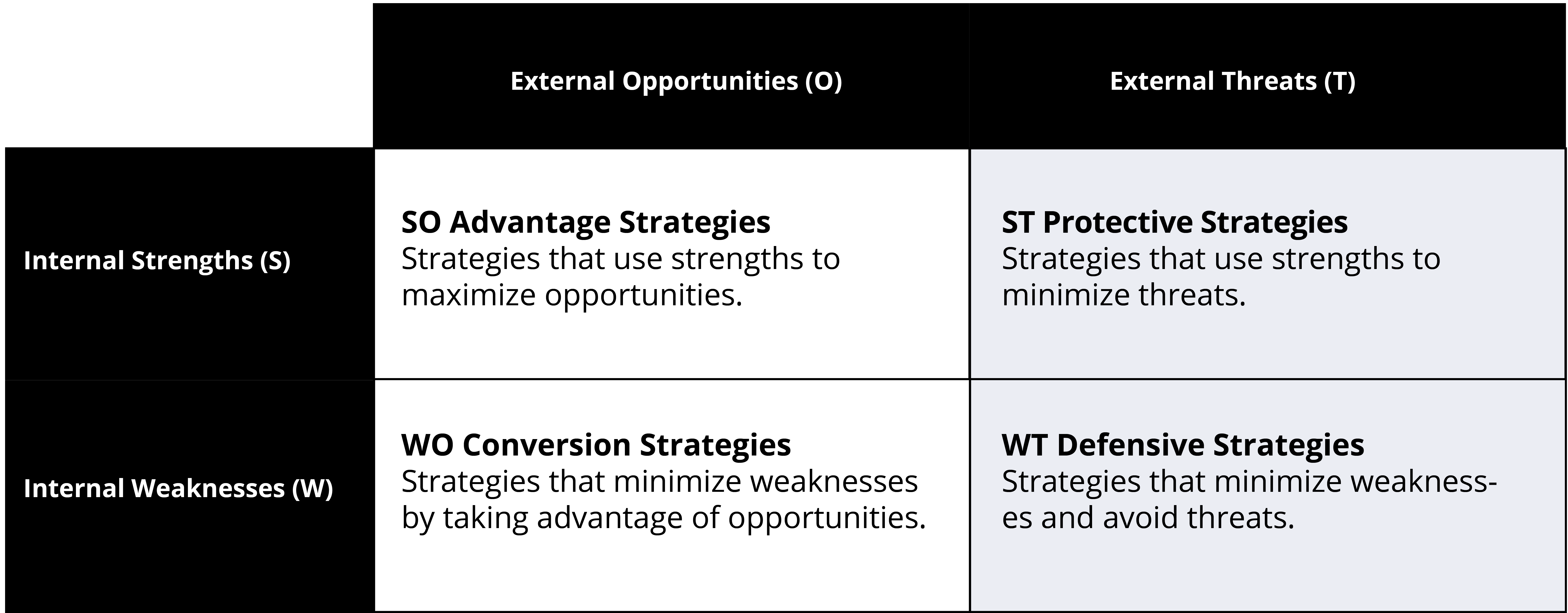With your pre-planning activities and market assessment complete, your planning team can now roll up their sleeves and dig into building your plan.
This article will cover the essentials to developing your strategic plan. If your organization wishes to review and revise your mission statement, vision statement, and core values as part of this process, we recommended deep-diving into our complete guide to strategic planning.
Step 1: Use Your SWOT to Set Priorities
Using your SWOT analysis from your market assessment allows you to easily identify what your organization could pursue during the planning and execution process. To do this, use the TOWS matrix below to match your external opportunities and threats with internal strengths and weaknesses:

Use the matrix to identify a few distinct options for your planning team to evaluate. You’ll want to select the one matrix that will most greatly benefit your organization’s long-term vision of success, support your mission, and align to your values. After you’ve decided which TOWS Strategic Alternatives matrix most aligns to your organization’s desired direction, you can move on to defining your long-term strategic objectives.
Step 2: Define Long-Term Strategic Objectives
Armed with your TOWS Strategic Alternatives matrix and a completed SWOT analysis, your planning team can tackle one of the biggest strategic questions you’ll face during the planning process – “What must we focus on to achieve our vision of success? What are our “big rocks” or “pillars” that are crucial to our success?”These are the objectives that are 4-5 years in nature and help articulate your desired future state.
Here are a few other questions you might consider as part of this exercise:
- What are our stakeholder’s expectations as it relates to financial performance?
- What value is critical to deliver to our customers? What is our customer value proposition?
- What processes must we excel at to deliver our products, services, or customer value?
- What skills must our organization or team possess to execute these processes?
The outcome from your TOWS matrix and answers to these questions should be a framework of 4-6 long-term strategic objectives. We recommend following the balanced scorecard strategic objective framework to create a holistic plan.
Step 3: Set Organization-Wide Goals and Measures
After you’ve defined your long-term strategic objectives, you’ll need to translate them into goals and measures of success that your entire organization will clearly understand. This starts with turning your strategic objectives into performance targets and setting the goals to achieve those targets
These goals reflect shorter term actions, generally 1-3 years, to achieve your long-term objectives. They goals will serve as the basis of your organization’s annual strategic plan and define clear outcomes for the current year. To learn more, watch our video on SMART goals.
Step 4: Define KPIs
With your long-term strategic objectives set and short-term actions defined, you’ll need to define the Key Performance Indicators (KPIs) that will serve as the key measures having the most impact on moving your organization towards achieving your goals. These KPIs should outline the question: “How will we measure success?”
The outcome from defining your KPIs is 5-7 measures that you will watch during the next year to measure the performance of your plan. If you’d like to learn more on how to develop great KPIs, watch our Key Performance Indicators video.
Key Performance Indicators (KPI) are the key measures that will have the most impact in moving your organization forward. We recommend you guide your organization with measures that matter.
Step 5: Cascade Your Plan
With your plan’s annual goals defined, you can begin cascading short-term goals and actions that will help align your department and team members to your annual [and long-term goals]. This is where everyone will see how their individual actions support the achievement of your organization’s plan.
As you begin building out these goals, consider the following questions:
- What will it take for each department to support the achievement of annual goals?
- Who must do what by when?
- What remains to be solved?
The outcome from this exercise is to have functional department goals, actions, and clearly defined measures and targets for the next 1-2 years.
Bonus: Dive Deeper into Plan Building
This article is an articulation of the high-level process. If you’d like to dig deeper into the nuts and bolts of strategy building, you can download a free complete guide to strategic planning. If you’d like us to help guide your organization through the process, contact us here and we can develop a customized planning and execution solution to meet the needs of your organization.
Next, in our final part of this newsletter series, we will be covering how to roll out your plan and put a process in place for ongoing strategic plan management.











